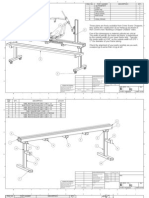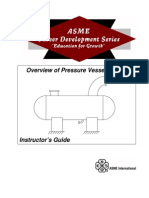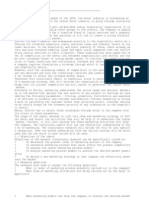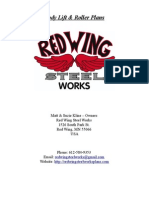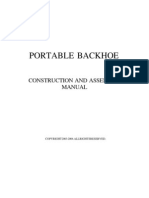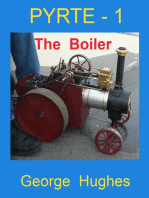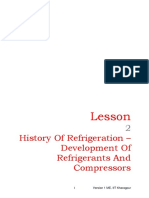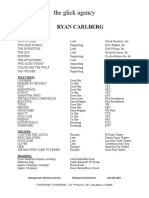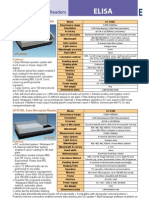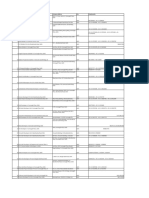Widetire Frame Fab
Widetire Frame Fab
Uploaded by
Riki MandolCopyright:
Available Formats
Widetire Frame Fab
Widetire Frame Fab
Uploaded by
Riki MandolCopyright
Available Formats
Share this document
Did you find this document useful?
Is this content inappropriate?
Copyright:
Available Formats
Widetire Frame Fab
Widetire Frame Fab
Uploaded by
Riki MandolCopyright:
Available Formats
10/16/13
widetire
Wide Tire Frame Fabrication
Before we get into the technicalities of the typical wide-tire frame it is important to understand that bikes built around wide rear tires have distinctly different handling characteristics than cycles using more conventional rubber. Some people say that wide-tired choppers handle poorly and this is a true statement up to a point but I prefer to say that a well-designed fat tire bike handles differently. Notice that I said well designed. Despite what we see in the popular chopper rags fat-tired choppers represent a very small minority of all the chopped bikes on the road today. If you attend many shows, rallies, swap meets and other events youll no doubt notice that for every wide-tired bike there will be at least fifty conventional bikes and this 50 to 1 ratio is substantiated by the feedback weve been getting from our clients and site visitors. In fact the vast majority of our customers and friends are building bikes that use 200mm or under rear tires by about a 100 to 1 ratio. At the last really big bike event I attended I only saw five wide-tired bikes parked in the streets along with around three thousand or so other rides but the show floor was full of fat tire scooter displays. It all comes down to appearance over practicality. Good looks and good handling dont always follow the same path but somewhere along the line you can reach a good compromise if you pay attention to details and dont get swayed by the latest fads or trends in show bikes. In my opinion, and it is only my opinion, the maximum size rear tire that can be used on a chopper designed for serious all-purpose road-work falls somewhere between a 180 to a 230mm with a 200 or course being the ideal candidate. An experienced rider wont notice much difference in the handling characteristics of a 200 compared to a 150 and depending upon the overall chassis design a bike equipped with such a tire can handle the twisty roads, traffic congestion and tight urban parking lot topography as well as most stockers or road racers. If the rider however is willing to modify their own behavior and to make some compromises in their riding style then they may be happier with a wider tire if they are going after some kind of look that they simply arent willing to give up. You cant dismiss the pursuit of appearance entirely. I have personally owned some bikes that handled miserably but they looked really good so I just adjusted my riding habits to suit the ride in question but I would not have ridden any of these bikes cross country as I personally prefer a very responsive cycle, that I ride, and not a cycle that rides me, if you know what I mean. For those who dont understand what Im talking about Ive included an excerpt from a rode test article in one of the Chopper magazines where the writer is talking about the handling characteristics of a pretty popular 250-tired softail bike: The fat rear tire causes a slight constant pull to the left due to the engine and transmission offset but nothing that changing your riding position cant overcome. The overall handling of the bike is fine but there is a limit to the lean angles and sometimes the bike feels a little unstable with sudden lurches in corners. On many occasions I found myself scraping the lower frame rails and on lefthanders grinding the primary cover or kickstand. The six over forks combined with the wide rear tire make it a little inconvenient to maneuver in tight traffic and winding roads caused us to slow significantly. A better suspension system would help tremendously as the frame bottoms out even over slight road irregularities due to the increased weight of the tire and swing-arm. This bike is probably best suited for straightaway highway cruising.
www.chopperhandbook.com/widetire.htm
In another article, this time written for a road test of a fat rigid frame the rider wrote:
1/10
10/16/13
widetire
In another article, this time written for a road test of a fat rigid frame the rider wrote: The process of getting familiarized was a combination of fighting it and becoming its best friend. At first I had to muscle it into submission just to keep it on the road. The bike is a little cumbersome and clumsy at low speeds. It takes concentrated steering effort and not just normal body-english to get it into sweeping turns but once into the corner the bike remains on its line relatively well. Ive been around a long time and in my opinion these articles were using sales-speak for This bike is piece of crap and should be used for show purposes only. The writers were basically telling us laymen how to enjoy eating a tough steak when they should have been telling us how to find a good steak to begin with but when you have to answer to your advertisers you have to compromise your ethics just a little bit. Most of the folks I know who have built fat-tired rides have enjoyed them for what they are and thats a show piece or bar-hopper but I dont know anybody whod build another one which says a lot about their usefulness. Its great to have one in the garage to show people but its a whole lot better if you also have a serious rider parked next to it. Fat tired bikes require the builder to do far more design planning than more conventional cycles as there are simply more variables involved. First and foremost is the selection of the tire itself as there can be considerable variation in the actual tire dimensions from one manufacturer to the next. Then comes the selection of the wheel, which also has some bearing on how wide the mounted tire will be at the widest point in the sidewall. Once the wheel and tire have been selected its up to the builder to decide whether they want to go with a chain or belt final drive and what size chain or belt to use. Most experts wont endorse the use of belts with wide rubber but the vast majority of folks still insist on running a belt anyway. The selection of the drive system has a tremendous impact on the design width of the rear wishbones and lower rails and the minimum to maximum clearance can vary by as much as one inch on the drive side rails. Once you decide on the drive system youll have to find out if you can buy an offset kit that will accommodate the components youve selected up to this point or whether youll have to have something custom made. In the mix youll also have to consider whether or not you want to opt for a right side drive transmission so you wont have to offset the motor and tranny. If you find that you can buy all of the components youll need you must also be prepared to either look into a hotter power plant of be willing to ride in the rear of the pack since the average fatty weighs anywhere between a fifty and a hundred pounds more than a conventional bike. Before you start building a wide tired bike you must be prepared for some of these compromises you may have to make and you must also be prepared for the additional expenses such bikes demand and these expenses are considerable compared to a more conventional chopper. If youre willing to make such concessions and you have the money well not waste any more time and get right into it in the next section.
Wide Tire Frame Buildup
Part I The Design The frame for this particular project will be designed for a 250mm rear tire using XLO final chain drive. Well get into the difference of chains versus belts elsewhere. Like the Old School chopper frame it is stretched four up and two out in front with two inches of stretch rearward in the lower rails and wishbones. All tubing is 1.25x.120 ERW and all bends use a 4.5 centerline radius. Ground clearance is 3.75 inches. These design parameters result in a frame having a rakish profile if used with a higher Sportster type tank yet low enough to use a sculpted tank if desired for a more streamlined ground-hugger appearance. Rake is anticipated to be 38 degrees but well wait until later to make a final determination about that. For the sake of descent handling well be using a Baker right-side-drive transmission so we dont have to offset the engine and tranny. Even though it is more expensive at least the rider wont have to sit sidesaddle or let the right ass-cheek droop over the seat to keep the rig balanced. Major materials needed for the frame proper are thirty lineal feet of 1.25 x .120 ERW tubing and two feet of 1x2x.120 inch rectangular tube sections. The overall geometry for the frame is nearly identical to that of the Old School Chopper frame we did in the earlier series with the exception of the additional bends in the wishbones and lower rails that we'll detail as we go. This particular frame even in it's most conservative stance is massively wide as shown in Figure 6.103 below.
www.chopperhandbook.com/widetire.htm
2/10
10/16/13
widetire
Figure 6.103
In this snapshot we've just taken the rear wishbones and backbone of a 250-frame section and laid it atop the Old School frame to provide some indication of how much wider a 'wide-tire' frame actually is in comparison to a conventional chassis. The wishbones for a 360 are over 4 inches wider than the ones shown here. Figure 6.104 shows the major frame dimensions in profile view.
Figure 6.104
These dimensions can be used to build a wide tire frame that handles anything from a 180 to a 360 with the differences between any particular wheel/tire size being made in the outward bends, when viewed from above, of the rear wishbones and the rear section of the lower frame rails. Before you undertake a wide tire project it is, in my opinion, essential that you have the wheel, tire, sprocket or pulley and fender for your particular project in the shop so you can make real measurements of the components you're going to use. This is the only way you're going to be able to make a 'tight' frame. Most aftermarket mass-produced wide tire frames are built to 'maximum' dimensions that take into consideration the 'worse-case' scenario of a combination of components and this is why you sometimes see as much as two inches of 'air-space' between the frame rails and the sides of the fender on some bikes. Our objective is to build a frame that fits the components perfectly to create a nice 'tight' fit between the rails and the other component parts. Before we go much further it should be understood that building a nice wide tire frame is as much art as it is technicalities and no two builders will produce the same frame even if they're both using the same set of design dimensions. These are not the type of frames to make your break-in to frame building on and I urge the first time fabricator to build a couple of conventional frames before trying to tackle a wide tire design. You must have a good bender for these frames and you must be very familiar with the characteristics and idiosyncrasies of your particular bending equipment before you tackle one of these monsters. The dimensions for the rear wishbones are shown in Figure 6.105 below.
www.chopperhandbook.com/widetire.htm
3/10
10/16/13
widetire
Figure 6.105
As we mentioned earlier this particular design is for 250mm rear tire running a 1.02" XLO chain so we're shooting for a clear dimension of 13" between the insides of the rear frame rails so you could run a 230/240 with a 1-1/8" belt. Depending upon the bender you're using you'll need two sections of 1.25 x.120" tubing between 36 and 38 inches long for each rail. As you can tell from the diagram the inside width of the rails can be set by either changing the angles where the frame starts to flare out and/or lengthening or shortening the dimension of the tangent sections between the two rearmost bends that define the flare. The width of the rails forward of the fender mount cross member, which is 10.875" to the outside, is set for all practical purposes by the width of the oil tank you're going to use and can vary from as narrow as 10.5" to as much as 11.25". We've found 10.875 to be a good compromise for most tanks. Remember that the actual width inside the rear rails is dependent upon the wheel/tire combo and drive system and braking setup you elect to use and can vary considerably from the dimensions we've used for this particular project. It is also interesting to note that the shape and size of the rear fender you're planning on running has a lot to do with exactly where you want to begin the bends for the rear flare outs. In this diagram we're showing a smooth rolled fender that follows the elliptical profile of the tire section. It barely clears the rails where they begin to narrow in. A flatter fender would require that the bends be started further towards the front. Before you start bending these up it's a good idea to go around and carefully study, examine and measure up as many wide tire frames as you can. You'll find that there are tremendous variations in the approaches that the various manufactures and custom builders take towards fabrication of these pieces. Sometimes a builder will use some large radius dies so that the entire wishbone looks like it's a series of long very gentle compound curves. Other builders use small radius dies and shorten up on the small straight sections so it's easier to fit a flatter fender but the frame will look more angular. On our design we took the middle road for a style that's about half way between streamlined and angular. There is no 'correct' way to build one of these frames and there are no 'standard' formulas or dimensions since they should ideally be custom built for specific components otherwise they'll look kind of bulky and out of proportion. The wishbones are built exactly the same way as the wishbones for the Old School project bike. The only difference of course is that you have four more bends to create the width necessary for the fat tire as seen below. Use the same process and you wont have any problems building these.
Figure 6.106
www.chopperhandbook.com/widetire.htm
4/10
10/16/13
widetire
Figure 6.107
Figure 6.108 Part 2 The Right Side Down Tubes and Lower Rails Weve had a significant amount of email from prospective builders out there who are not only trying to build their first frame but also learning the ins and outs of their particular benders at the same time. Taking this into consideration we decided to add a little more detail in this section that hopefully shows some of the typical steps used in putting bends in a tube run. Keep in mind that each bender will be different and the procedures shown here might not look the same on vertical type benders or other types but the concepts will remain the same. As Ive mentioned elsewhere I find it easier to work from the top forward end of the lower rails where the down-tubes meet the headstock or backbone and work towards the rear. Other builders do just the opposite so its a matter of personal preference. Figure 6.109 shows the first Down-tube bend in progress. This is exactly the same process and uses the same procedures and dimensions as making the so-called front ramp bends in the down tubes on the Old School frame in the previous section.
www.chopperhandbook.com/widetire.htm
5/10
10/16/13
widetire
Figure 6.109 Figure 6.110 shows the first Down-tube bend at completion.
Figure 6.110 Figure 6.111 shows the tube moved forward 4 per plan (3.5" for our bender) and set up for the second bend in the series.
Figure 6.111 Figure 6.112 shows the second bend at completion.
www.chopperhandbook.com/widetire.htm
6/10
10/16/13
widetire
Figure 6.112 These two bends create what I call the 'ramp' in the down-tubes where they transition into the lower frame rails. Both of these bends lay in the same plane as the normal centerline of the whole tube run. If we took it out of the bender and laid it on the shop floor at this point it would lay perfectly flat. You can repeat the process to make the ramp bends in the left side down tube and lower rail. What the snapshots dont show clearly is that any one of these bends can be what some mistakenly call a compound bend which usually arent used in race car or bikes frames to begin with. The term for a bend that changes direction from the normal x-y-z plane of the tubes longitudinal axis probably should be called a complex or rolled bend and they occur any time the tube is rotated in the bender to change the direction of any particular bend in relation to the preceding one. This type of bend is impossible to see or illustrate in a regular 2D shop drawing and this is where 3D graphics are much more helpful to the designer. Rotating the tube in the bender is the way you control the direction of the bends and this technique is hard to grasp until you start bending up some tubes and gets a little complicated since the direction of rotation changes from the left to the right side of the bike. Moving on we slip the tube down to the point where we want the lower rails to begin widening near the location of the rear transmission mount cross member. The entire tube run is rotated in the bender so that the direction of that outward turning bend is pointed in the correction direction. Figure 6.113 shows the tube setup and ready to make that outward bend in the lower rail (this is the rail for the right side of the frame). If you were bending the left side rail the down-tube would be pointing downward which is why you want the bender mounted at least 36" above the shop floor.
Figure 6.113 Figure 6.114 shows the outward bend being made.
Figure 6.114 The process can be repeated for the left side rail but remember that the down tube will be pointing downward at a slight 9 to 10 degree angle from vertical.
www.chopperhandbook.com/widetire.htm
7/10
10/16/13
angle from vertical.
widetire
Figure 6.115 When you're finished with the initial out-bends the lower rails should look somewhat like those in Figure 6.115. Notice that the tubes is still 'flat' relative to the plane of the forward section of the lower rails at this point but they splay out as they extend rearward (near the yellow flashlight). You'll notice on some frames, Santee's come to mind, that this aft section of the rail is not flat and has already started to be bent very slightly in an upward direction. We're now ready to move a little further along and rotate the tube for a tricky bend that seems to be throwing some folks off track. This last bend in the rail is one of those 'rolled' bends that are going in two directions at one time. In other words the tube is being bent upward towards the axle plate but at the same time it is also being bent back inwards towards the center of the frame so it lies in plane that is parallel with the main section of the lower rails. Even though it sounds complicated it is very simple and just involves rotating the tube in the bender as shown in Figure 6.116.
Figure 6.116 After the bend is made the tube will sloped upward at an angle of 25 degrees, viewed from the side, and be bent back into a line running parallel with the lower side rail all with a single bend as seen in the snapshot of Figure 6.117 that follows.
www.chopperhandbook.com/widetire.htm
8/10
10/16/13
widetire
Figure 6.117 As these bends are being made I admit that it can seem a little complicated keeping a mental picture of all of the planes and angles in the back of your mind but with practice these types of gyrations will become second nature and bending up one of these wide-tire side rails will take less than five minutes. Believe it or not I know some 'shade-tree' builders who can do this stuff by eye faster than I can whip out my calculator. A nice cheap way to make practice runs is to use regular old 1" EMT electrical conduit. The actual outside diameter is just shy of 1.25" so it will kink and flatten slightly in the bender but at $5.00 for a ten-foot length it is a very fast and cheap way to learn how to handle the basic operations of a bender. In addition some people underestimate exactly how hard it is to learn how to use a bender in the first place. Bending tubes is a lot like welding in that you've either got the knack or you don't but remember that very few custom bike builders can bend their own tubes or do their own welding, hardly anybody can actually do both. Again I want to remind the reader that there is no 'standard' formula or dimensions or angles for doing wide tire frames. Every builder will handle the angles, offsets and lengths differently and they also change depending upon the size of the rear wheel, drive setup, brake location and other factors such as fender width and shape. A couple of good frames to examine to compare how different companies handle a wide tire frame are Santee and Daytec, especially in how they shape the bends in the lower rear rails. Another example of the wide variation in design styles is to look at axle lengths used by the various manufacturers for their typical '250' frames and you'll find that they range from 14" to 16.5" for the same drive setups. Thats a pretty significant difference from the various builders, all of them building for the exact same rear tire setup.
Part 3 The Left Side Down Tubes and Lower Rails Moving on to the left side of the frame were ready to repeat the procedure except this time everything will appear to be upside down to what we did for the right side of the frame. We already bent the ramp in the left side rail so all we really have to do now is to make the out-bend and then the rotated up-bend.
Figure 6.118 You can see the left side tube with the ramp already bent has been placed in the bender in preparation for making the out-bend that heads in just the opposite direction of the out-bend on the right side of the frame. Compare the tube orientation with that in Figure 6.113 for the out-bend on the rail for the right side of the bike. Since all benders only work in one direction we have to put the tubes in upside down compared to the orientation we used when doing the right side bends. Figure 6.119 shows the out-bend for the left side lower rail at completion.
www.chopperhandbook.com/widetire.htm
9/10
10/16/13
widetire
Figure 6.119 Both rails are now finished and ready for fitting to the backbone.
Figure 6.120 As Ive mentioned earlier there is no one way to build a wide tire frame and no right way to learn how to bend the tubes. The tubebending section of the Handbook provides some good tips on learning how to do rotated bends and the end results of a nicely contoured set of wide rails are worth the effort of practicing. In my opinion nothing looks more amateurish than the typical hoop type frames some people are building just because they arent willing to truly master the art of bending.
| Main Page | Copyrights | Terms of Use | Warranty Disclaimer | Security and Privacy | Contact | Copyright 2003-11, All Rights Reserved
www.chopperhandbook.com/widetire.htm
10/10
You might also like
- Tom Thumb Mini BikeDocument4 pagesTom Thumb Mini Bikemysteriousracerx100% (7)
- How To Build A Mini ChopperDocument25 pagesHow To Build A Mini ChopperAshleigh Kuykendall50% (2)
- A Do-It-Yourself Manual Tire ChangerDocument4 pagesA Do-It-Yourself Manual Tire ChangerHamzaNouman50% (2)
- Ted Dekker Chosen Graphic Novel Zlibraryexau2g3pDocument163 pagesTed Dekker Chosen Graphic Novel Zlibraryexau2g3pPeaJesterNo ratings yet
- 45 Best Harbor Freight ModsDocument48 pages45 Best Harbor Freight ModsKeone Semana100% (3)
- Crimescene Choppers JIG PlansDocument10 pagesCrimescene Choppers JIG Planspete_clarke633388% (8)
- Fat Drifter Specs.Document9 pagesFat Drifter Specs.Jacqueline La Cantonnaise60% (5)
- Old School Frame FabDocument51 pagesOld School Frame FabRiki Mandol100% (4)
- How To Build A Drift TrikeDocument21 pagesHow To Build A Drift TrikeCBARDO100% (3)
- Cycle Car With Moto WheelDocument83 pagesCycle Car With Moto Wheelsapientwon7712100% (1)
- Donny’S Unauthorized Technical Guide to Harley-Davidson, 1936 to Present: Volume Iv: Performancing the EvolutionFrom EverandDonny’S Unauthorized Technical Guide to Harley-Davidson, 1936 to Present: Volume Iv: Performancing the EvolutionRating: 4 out of 5 stars4/5 (1)
- Building 4.6/5.4L Ford Horsepower on the DynoFrom EverandBuilding 4.6/5.4L Ford Horsepower on the DynoRating: 5 out of 5 stars5/5 (1)
- Donny’S Unauthorized Technical Guide to Harley-Davidson, 1936 to Present: Volume I: the Twin CamFrom EverandDonny’S Unauthorized Technical Guide to Harley-Davidson, 1936 to Present: Volume I: the Twin CamNo ratings yet
- Pressure Vessel Design ASME GuideDocument137 pagesPressure Vessel Design ASME Guidesmasudbd100% (17)
- Bomba de Diafragma Samoa DF50 PDFDocument54 pagesBomba de Diafragma Samoa DF50 PDFArnulfo Diaz CuellarNo ratings yet
- SofitelDocument5 pagesSofitelcoolasthas0% (1)
- Forks 1Document24 pagesForks 1Riki Mandol100% (1)
- RockersDocument11 pagesRockersRiki Mandol100% (1)
- Chopper Handbook Tube BenderDocument20 pagesChopper Handbook Tube Bendermendingojr100% (5)
- Offroad Kart PlanDocument24 pagesOffroad Kart PlanAnshul Kothari100% (1)
- Spring BuildDocument47 pagesSpring BuildRiki Mandol100% (4)
- Chopper Frame Plans Drawing Advantage SummaryDocument12 pagesChopper Frame Plans Drawing Advantage Summarycustomchoppersguide100% (2)
- Fee Jee PMFM47Document7 pagesFee Jee PMFM47Jim100% (3)
- Welding JigsDocument15 pagesWelding JigsRiki MandolNo ratings yet
- The Chopper Builders Handbook Notch-O-Matic' Tube Notcher The DesignDocument26 pagesThe Chopper Builders Handbook Notch-O-Matic' Tube Notcher The Designgww25100% (2)
- Web QCGBDocument19 pagesWeb QCGBpramponiNo ratings yet
- Construir Moto ChopperDocument7 pagesConstruir Moto ChopperAngel Dure100% (2)
- How To Build A Tube Bender WWDocument9 pagesHow To Build A Tube Bender WWmikefcebu100% (1)
- Tubing BenderDocument9 pagesTubing BenderAdam Rath67% (3)
- How To Build A MultimachineDocument80 pagesHow To Build A MultimachineTerrence LopezNo ratings yet
- Membuat Mini Bike Mesin KompresorDocument8 pagesMembuat Mini Bike Mesin Kompresormawan_jogjaNo ratings yet
- Go KartDocument20 pagesGo KartVikas PuppalaNo ratings yet
- Body Lift Roller PlansDocument50 pagesBody Lift Roller PlansEllyn MohdNo ratings yet
- PowerCycle With SideCarDocument7 pagesPowerCycle With SideCarJim100% (2)
- Buggy Double Aarm FrontDocument38 pagesBuggy Double Aarm Frontzeljko8788% (8)
- Pembuatan Dan Perencanaan GriderDocument15 pagesPembuatan Dan Perencanaan GriderErwan AchmadyaniNo ratings yet
- Mite Cycle by Mechanix IllustratedDocument7 pagesMite Cycle by Mechanix IllustratedJim100% (3)
- Build The Ison Race KartDocument8 pagesBuild The Ison Race KartJim100% (2)
- Motorcycle LiftDocument26 pagesMotorcycle LiftChristos Papadakis100% (1)
- Podkop 1Document20 pagesPodkop 1Olin Stej83% (6)
- Guide to Modified Exhaust Systems: A Reference for Law Enforcement Officers and Motor Vehicle InspectorsFrom EverandGuide to Modified Exhaust Systems: A Reference for Law Enforcement Officers and Motor Vehicle InspectorsNo ratings yet
- Truck Beds: How to Install, Restore, & Modify: How to Install, Restore, & ModifyFrom EverandTruck Beds: How to Install, Restore, & Modify: How to Install, Restore, & ModifyNo ratings yet
- Donny’S Unauthorized Technical Guide to Harley-Davidson, 1936 to Present: Volume Vi: the Ironhead Sportster: 1957 to 1985From EverandDonny’S Unauthorized Technical Guide to Harley-Davidson, 1936 to Present: Volume Vi: the Ironhead Sportster: 1957 to 1985No ratings yet
- 50 Years of Engine Repair Solutions for American Muscle Cars, Street Rods, and Kit CarsFrom Everand50 Years of Engine Repair Solutions for American Muscle Cars, Street Rods, and Kit CarsNo ratings yet
- Chevy/GMC Trucks 1967-1972: How to Build & Modify: How to Build & ModifyFrom EverandChevy/GMC Trucks 1967-1972: How to Build & Modify: How to Build & ModifyNo ratings yet
- A Book of Helpful Tips on Overhauling a Vintage Engine - Including Car, Motorbike and Lawn Mower EnginesFrom EverandA Book of Helpful Tips on Overhauling a Vintage Engine - Including Car, Motorbike and Lawn Mower EnginesRating: 5 out of 5 stars5/5 (1)
- Classic Car Restoration Tips: for everybody who wants to restore a classic carFrom EverandClassic Car Restoration Tips: for everybody who wants to restore a classic carNo ratings yet
- Installing a Garage Door and Opener- Special Bundle: Cake Decorating for BeginnersFrom EverandInstalling a Garage Door and Opener- Special Bundle: Cake Decorating for BeginnersNo ratings yet
- GTO Data and ID Guide: 1964-1974: Includes: The Judge, Ram Air III, Ram Air IVFrom EverandGTO Data and ID Guide: 1964-1974: Includes: The Judge, Ram Air III, Ram Air IVNo ratings yet
- Oxy-Acetylene Welding and Cutting: Electric, Forge and Thermit Welding together with related methods and materials used in metal working and the oxygen process for removal of carbonFrom EverandOxy-Acetylene Welding and Cutting: Electric, Forge and Thermit Welding together with related methods and materials used in metal working and the oxygen process for removal of carbonRating: 4 out of 5 stars4/5 (1)
- Donny's Unauthorized Technical Guide to Harley Davidson 1936 to Present: Volume Ii: Performancing the Twin CamFrom EverandDonny's Unauthorized Technical Guide to Harley Davidson 1936 to Present: Volume Ii: Performancing the Twin CamNo ratings yet
- A Practical Workshop Companion for Tin, Sheet Iron, and Copper Plate Workers: Containing Rules for Describing Various Kinds of Patterns used by Tin, Sheet Iron, and Copper Plate Workers, Practical Geometry, Mensuration of Surfaces and Solids, Tables of the Weights of Metals, Lead Pipe, Tables of Areas and CircumferencesFrom EverandA Practical Workshop Companion for Tin, Sheet Iron, and Copper Plate Workers: Containing Rules for Describing Various Kinds of Patterns used by Tin, Sheet Iron, and Copper Plate Workers, Practical Geometry, Mensuration of Surfaces and Solids, Tables of the Weights of Metals, Lead Pipe, Tables of Areas and CircumferencesNo ratings yet
- Wrought Ironwork - A Manual of Instruction for Rural CraftsmenFrom EverandWrought Ironwork - A Manual of Instruction for Rural CraftsmenRating: 5 out of 5 stars5/5 (1)
- Pump Test BrochureDocument12 pagesPump Test BrochureRiki MandolNo ratings yet
- Academic MisconductDocument24 pagesAcademic MisconductRiki MandolNo ratings yet
- Fouling of Heat Exchangers - T R Bott PDFDocument530 pagesFouling of Heat Exchangers - T R Bott PDFRiki MandolNo ratings yet
- Graduate School: P.O. Box 44610 Lafayette, LA 70504-4610 Office: (337) 482-6965 Fax: (337) 482-1333Document1 pageGraduate School: P.O. Box 44610 Lafayette, LA 70504-4610 Office: (337) 482-6965 Fax: (337) 482-1333Riki MandolNo ratings yet
- Solvay Process PresentationDocument19 pagesSolvay Process PresentationRiki Mandol67% (3)
- RefrigerationDocument15 pagesRefrigerationRiki MandolNo ratings yet
- History of Refrigerants PDFDocument18 pagesHistory of Refrigerants PDFAnand VardhanNo ratings yet
- Fungal Pretreatment of Lignocellulosic BiomassDocument11 pagesFungal Pretreatment of Lignocellulosic BiomassRiki MandolNo ratings yet
- Fouling of Heat Exchangers - T R Bott PDFDocument530 pagesFouling of Heat Exchangers - T R Bott PDFRiki MandolNo ratings yet
- Fuel Cells NPTEL Full Course PDFDocument184 pagesFuel Cells NPTEL Full Course PDFRiki MandolNo ratings yet
- Numerical Analysis PDFDocument7 pagesNumerical Analysis PDFRiki MandolNo ratings yet
- Numerical Analysis PDFDocument10 pagesNumerical Analysis PDFRiki MandolNo ratings yet
- Numerical Analysis PDFDocument8 pagesNumerical Analysis PDFRiki MandolNo ratings yet
- TCC Number 174 4Document2 pagesTCC Number 174 4Dennis RimandoNo ratings yet
- Priyanka ModakDocument5 pagesPriyanka Modaknavatha25No ratings yet
- Automotive Interview Questions 1707472977Document2 pagesAutomotive Interview Questions 1707472977emsm06No ratings yet
- Quantum DXi-Series Configuration and Best Practices Guide For Veeam Backup & ReplicationDocument30 pagesQuantum DXi-Series Configuration and Best Practices Guide For Veeam Backup & ReplicationCarlos RosilloNo ratings yet
- Foundation Acc Full Sol Set 15.11.2021Document245 pagesFoundation Acc Full Sol Set 15.11.2021adityatiwari122006No ratings yet
- Business Report Project Machine Learning Rupesh Kumar DSBA-A5-21C-2021Document77 pagesBusiness Report Project Machine Learning Rupesh Kumar DSBA-A5-21C-2021Rupesh Gaur100% (2)
- Kami Export - UnitConversions2SEDocument7 pagesKami Export - UnitConversions2SEmichelle zagazetaNo ratings yet
- Ryan Carlberg Resume 2018 PDFDocument1 pageRyan Carlberg Resume 2018 PDFapi-528606282No ratings yet
- Mes - Case StudyDocument2 pagesMes - Case StudyMilton Fonseca ZuritaNo ratings yet
- Syllbus 4 Marketing 4th SEMDocument5 pagesSyllbus 4 Marketing 4th SEMAmit VermaNo ratings yet
- Jotun Paints PresentationDocument52 pagesJotun Paints Presentationswapneel_kulkarni100% (1)
- Diagrama Volvo FH Pedal Acelerador PDFDocument1 pageDiagrama Volvo FH Pedal Acelerador PDFJulio SanchezNo ratings yet
- Unit No. VI Factor PricingDocument11 pagesUnit No. VI Factor PricingMuhammad Yasir IqbalNo ratings yet
- Another Proof of Wedderburn's TheoremDocument3 pagesAnother Proof of Wedderburn's TheoremJacksonNo ratings yet
- 32 Degrees of Adjectives - Turkish Language LessonsDocument6 pages32 Degrees of Adjectives - Turkish Language LessonsAlongMXNo ratings yet
- 2017-18 Ap English LanguageDocument10 pages2017-18 Ap English Languageapi-216774555100% (1)
- Stripes CardiganDocument6 pagesStripes CardiganMary008100% (3)
- CD8227GPDocument8 pagesCD8227GPJosé Miguel Barbosa HernándezNo ratings yet
- Elisa - CatalogDocument3 pagesElisa - Catalogdéborah_rosalesNo ratings yet
- Math 11 STEM Pre Calculus Q2 Week 7 2Document11 pagesMath 11 STEM Pre Calculus Q2 Week 7 2Zent Kierlby MorgadoNo ratings yet
- Garment Operator Training InitiativesDocument4 pagesGarment Operator Training InitiativesAiswarya sNo ratings yet
- Skinless Longanisa I. ObjectivesDocument3 pagesSkinless Longanisa I. ObjectivesJustclick CompNo ratings yet
- 801248001-ESL-Brains-Excuse-me-where-is-the-food-court-giving-directions-SV-7673-A2Document3 pages801248001-ESL-Brains-Excuse-me-where-is-the-food-court-giving-directions-SV-7673-A2Rocio AcostaNo ratings yet
- 3rd Grading Physics 2022 Summative QuizDocument2 pages3rd Grading Physics 2022 Summative QuizOdessa SantosNo ratings yet
- Columbine Report Pgs 901-1000Document100 pagesColumbine Report Pgs 901-1000columbinefamilyrequestNo ratings yet
- HSE Requirements-Rev01 - Site RequirmentDocument1 pageHSE Requirements-Rev01 - Site RequirmentBRC HSE Dept.No ratings yet
- Market Mapping NorthDocument121 pagesMarket Mapping Northshardul.vishalNo ratings yet





